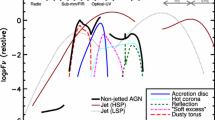Multicolor photometric data are presented for the asynchronous polar V1500 Cyg during 2000–2009, i.e., 23–35 years after its outburst. Some examples of individual light curves of the system are shown. An analysis of these reveals large variations in its brightness and color with the phase of the orbital period owing to a “reflection effect” caused by reradiation from the side of the red dwarf facing the hot white dwarf and heated by its hard ultraviolet radiation. The variations in the O-C residuals and in the maximum intensity with the phase of the synodic period are illustrated. It is found that the amplitude A of the orbital fluctuations increases in proportion to the intensity I at a rate dA/dI=0.64. This behavior of V1500 Cyg is most likely caused by periodic shading of the illuminated part of the red dwarf, where the degree of shading depends on the phase of the synodic cycle.
Similar content being viewed by others
References
E. Pavlenko and J. Pelt, Slow variability of V1500 Cyg, IBVS 3252, 1–4 (1988).
E. P. Pavlenko and J. Pelt, Synchronization of the components of the magnetic nova V1500 Cyg, Astrofizika 34, 169 (1991).
G. D. Schmidt and H. S. Stockman, Astrophys. J. 371, 749 (1991).
I. L. Andronov, Astron. zh. 63, 97 (1987).
I. Semeniuk, A. Olech, and M. Nalezyty, AcA 45, 747 (1995).
G. D. Schmidt, J. Liebert, and H. S. Stockman, Detection of the hot white dwarf in the magnetic nova V1500 Cygni with the Hubble Space Telescope, Astrophys. J. 441, 414 (1995).
E. P. Pavlenko, Odessa Astron. Publ. 16, 41 (2003).
Ja. Kaluzny and I. Semeniuk, AcA 37, 349 (1987).
E. P. Pavlenko, S. Yu. Shugarov, and N. A. Katysheva, Astrofizika 43, 567 (2000).
A. Kruszewski, J. Semeniuk, and H. W. Duerbeck, Ibid., Nos. 3–4, 339 (1983).
J. Patterson, Astrophys. J. 225, 954 (1987).
J. C. Kemp, R. King, T. E. Parker, et al., Publ. Astron. Soc. Pacif. 91, 214 (1979).
A. A. Litvinchova, E. P. Pavlenko, and S. Yu. Shugarov, Odessa Astron. Publ. 20, 112 (2007).
E. P. Pavlenko, et al., ASP Conf Ser. 261, 651 (2002).
V. I. Marsakova and I. L. Andronov, Odessa Astron. Publ. 9, 127 (1996).
E. P. Pavlenko and S. Yu. Shugarov, ASP Conf. Ser. 335, 257 (2005).
D. S. Hall, Pseudosynchronization found in binaries with eccentric orbits, Astrophys. J. 309, L83 (1986).
G. D. Schmidt, J. Liebert, and H. S. Stockman, Astrophys. J. 441, 41 (1995).
Author information
Authors and Affiliations
Corresponding author
Additional information
Translated from Astrofizika, Vol. 54, No. 1, pp. 47–62 (February 2011).
Rights and permissions
About this article
Cite this article
Litvinchova, A.A., Pavlenko, E.P. & Shugarov, S.Y. Nova Cygni 1975 (V1500 Cyg) in 2000–2009 and the nature of its synodic period. Astrophysics 54, 36–51 (2011). https://doi.org/10.1007/s10511-011-9156-y
Received:
Accepted:
Published:
Issue Date:
DOI: https://doi.org/10.1007/s10511-011-9156-y




